
Booth alumnus Russ Maki, ’95 (XP-64), helps bring irreplaceable documents back to life—including a monumental record from Booth’s past.
- By
- October 10, 2016
- Student Experience

It’s a humble brown and white pamphlet, no bigger than the size of a small notebook. Its pages are few, but its contents bear witness to a landmark in the history of business education: the world’s first executive MBA program.
The pamphlet, labeled “Executive Program Directory,” was distributed to the students of this new, innovative curriculum when it debuted in 1943 at Chicago Booth, then known as the School of Business.
A one-stop info shop, the book answers many questions a new student would have had: Where is my accounting professor’s office? When is the library open? And where is the designated smoking room?
This special piece of Booth’s history had been stored with the rest of the XP program archives until recently, when Deb Fallahay, associate director of operations for the program, brought it to the attention of Russ Maki, ’95 (XP-64). This encounter gave the 73-year-old document a new lease on life.
“This is incredible,” enthused Maki, as he showed off the pamphlet before its restoration, its pages stained and wrinkled with age. “I mean this is XP-1. This is the origin. This was the first executive program ever.”
As the owner of Chicago-based rare document restoration firm Graphic Conservation Co., Maki specializes in exactly this—bringing damaged documents back to life.
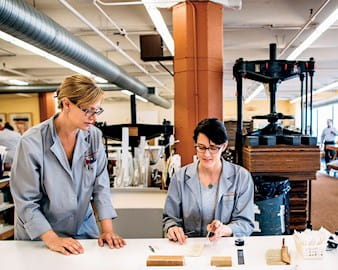
During CBM’s recent visit to the company’s South Loop office, a 10-foot-long aerial image of Chicago’s 1933 World’s Fair was being flattened a desk away from an M. C. Escher print laid low by poor framing. Other projects have arrived in even worse shape—crumpled, rolled, stained, or even burned. “Our job here is to do no harm,” Maki explained. “We make decisions about how far things can go. It’s a delicate decision-making process.”
All of the conservators’ work is reversible, and uses many of the same time-tested techniques around in 1921 when the now-independent company was founded as a department within commercial printing company R. R. Donnelley & Sons. Over the years, the department’s focus shifted from high-end bookbinding and leather tooling to art and document restoration. Donnelley sold the department to its managers in 1982, and Maki bought the company in 2009.
“The history of the printing process has always fascinated me,” said Maki. His office is filled with unique odds and ends that nod to that history—a vellum land grant older than the United States, Roaring Twenties–era currency with microprinting invisible to the naked eye, and a century-old tobacco silk emblazoned with a University of Chicago golfer, to name just a few.
A onetime paperboy for the Chicago Daily News, Maki found his calling when a friend’s dad who owned a printing company hired him to work in the prep area making plates used in the offset lithography process.
“I was 16 or 17, and it was fascinating because you’re working with your hands, or at least you were back then,” he recalled. “There was more of a craft to the world of printing than exists today.” A career in the commercial printing paper field followed, until an industry-wide downturn in the 1990s got him thinking about a new career path.
“I didn’t know it at the time, but I was secretly yearning for important work,” Maki said. “I am really helping people here, and that is a great feeling. There is an emotional component to what we do, and all of us feed off it, the entire team.”
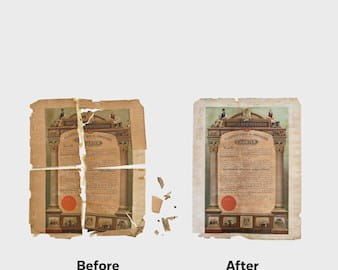
Today, clients seek out Graphic Conservation because of its top-notch body of work. They bring in damaged, even ragged rare documents and leave with treated work protected in archival matting and glazing materials designed to last decades.
“It’s great to see so many items coming through the door,” said head conservator Christina Marusich, as she peered into an aqueous bath removing stains from the border of a vivid red and blue woodblock print. Her favorite type of project? The difficult ones. “I like the challenge,” she said.
Most jobs require a team effort, she said, drawing on the multiple perspectives and specialties of the company’s conservators to find the best possible fix for irreplaceable pieces. “If the saying is, ‘Measure twice, cut once,’ then we measure 10 times,” she said.
Graphic Conservation has long been known for its ability to restore fine art and important historic and corporate documents, such as the XP-1 program directory. The lab has worked on one of five copies of the Gettysburg Address handwritten by Abraham Lincoln himself, and an original McDonald’s ledger book penned by company founder Ray Kroc.
“When the House resolution for the Thirteenth Amendment came into our lab, the entire company just stood around the table and said nothing for minutes.”
— Russ Maki
But lately, Maki has seen a boom in projects from a much different niche. “A huge portion of our growth is coming from the conservation and restoration of important family documents,” Maki said. Often, clients are amateur genealogists who seek out Graphic Conservation after inheriting a trove of belongings from a relative who passed away.
Call it the Antiques Roadshow effect, or chalk it up to a growing affinity for printed records in a world dominated by email and texts: clients are clamoring to give new life to old marriage licenses, diplomas, and even letters to Santa. “People are starting to realize there’s only one of these, and that someone needs to take care of it,” Maki said.
Such was the case with a project Maki said he will never forget—the repair of a badly damaged identification card carried during the Holocaust by a prisoner of the Mauthausen Concentration Camp in Austria.
“His descendants realized they had this treasure buried in an envelope sitting on a desk,” Maki recalled. A three-month restoration process filled in missing areas of paper, and conservators carefully removed tape that was further damaging it.
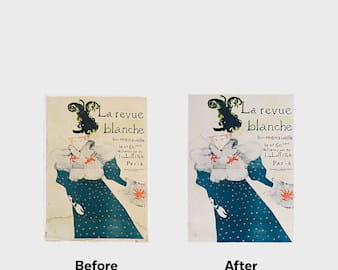
The document contained not only the man’s thumbprint, but the stamp of the Allied forces who eventually liberated the camp. Conservators were able to improve the appearance of both through a dry-cleaning process. The finished piece was framed using high-quality, archival materials that will keep it safe for years to come.
“Once the work was completed, I wanted to drop it off with the family and the moment just crystallized with them,” Maki said. Everyone was in tears. “This little one-inch-by-two-inch folded-up piece of paper now was unfolded. This paper that their great-grandfather was forced to carry in his pocket every day he was in the concentration camp is now in a safe enclosure, and people can experience it and talk about it.”
Many documents that pass through Graphic Conservation offer a window to the past, be they personal documents or materials of historic importance brought in by larger clients such as museums and galleries.
“I will never forget when the House resolution for the Thirteenth Amendment came into our lab. The curatorial team left, and the entire company just stood around the table and said nothing for minutes,” Maki said. Passed on February 1, 1865, the resolution—in just 47 words—formally ended slavery in the United States.
“You try to transport yourself back to that time, thinking that most of the people who signed that document were knowingly risking their lives in support of that,” Maki said. Indeed, President Lincoln was assassinated less than three months after its passage.
The original document resides in the National Archives in Washington, DC. The copy that came to the lab is owned by the State of Illinois, and is one of the precious few signed by Lincoln as well as most of the congressmen who voted for it. But time had taken its toll, threatening the very ink of those signatures.
Written on vellum, or animal skin, the document had wrinkled extensively, making its text less legible than before. To bring it back to life, the team embarked on a careful, six-month process to humidify and flatten the document. The successfully restored resolution is now at the Abraham Lincoln Presidential Library and Museum in Springfield, Illinois.
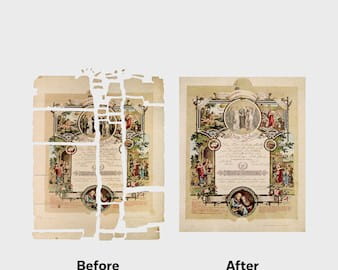
As rare as such projects are, the company has restored many iconic documents in its 95-year history, including broadsides of the Declaration of Independence and the Emancipation Proclamation, and rare original prints of the Articles of Confederation and the US Constitution. Pieces from an impressive array of major artists who have produced significant works on paper have been through the lab, from Pablo Picasso to Henri Matisse to Andy Warhol.
Conservators recently finished work on a set of US Army field orders for the Allied Invasion of Normandy on D-day in World War II, owned by a chief of staff among the troops who landed at Omaha Beach. For the Graphic Conservation team, projects such as these are a powerful reminder of the purpose of their work.
“To be honored with the opportunity of working on one of President Lincoln’s handwritten copies of the Gettysburg Address is as fine a compliment as you can receive in our field,” Maki said. “There is only one reason that you get that document to work on, and it is because you are legitimately the best at what you do.”
Back in the bright and airy lab, conservators have completed their two-month makeover of the XP-1 program directory. A dry-cleaning process removed ground-in dirt, and flattening techniques minimized creases and wrinkles. A custom, three-sided Mylar envelope was created to hold the pamphlet, as was a buffered rag-board support that will protect and stabilize it. The reassembled pamphlet looks just like it would have in the hands of the very first Executive MBA students.
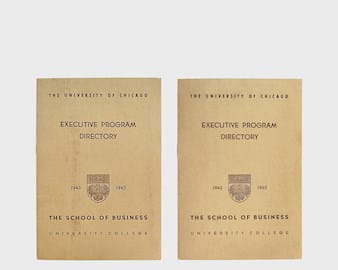
The XP-1 pamphlet restoration has given Maki a chance to reflect on his own time at Booth, and the legacy of this first cohort. “I can only imagine as they were getting started with this program, it had to have been very difficult,” he said. “My experience was that you were forced to dig deep to prove what was possible to yourself, because everyone in the program is actively engaged in an executive role in their company.
“At first you don’t realize it’s possible that you can do that, but the collegial nature of the program, the teamwork, and the caliber of the people that you’re trying to keep up with forces you to go into overdrive, and you do it.”
He credits Booth with giving him the skills needed to help Graphic Conservation thrive. The company has grown to multiple times its size since he took over, and Maki remains involved in many parts of the business, from marketing and sales to cost accounting, production, and the building out of its network of relationships.
And it’s gratifying that his work can give back to the school that gave him so much. His team plans to create a copy of each page of the directory that can be displayed individually, so future students can learn about these early trailblazers and the faculty members who taught them.
“Now people can actually see this document and realize they are a part of this program’s long lineage,” he said. For the Graphic Conservation team, it’s more than just a day’s work. “It’s a powerful reminder of the importance of the work we do.”